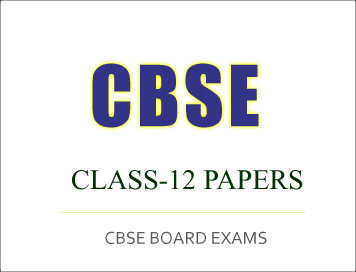CBSE Class-12 Question Papers for IOP/Comptt Examination 2017 : All India Scheme, Economics
Disclaimer: This website is NOT associated with CBSE, for official website of CBSE visit - www.cbse.gov.in
CBSE Class-12 Question Papers for IOP/Comptt Examination 2017
All India Scheme, (Economics)
CBSE Class-12 Question Papers for IOP/Cmptt Examination : Economics (Set-1)
ECONOMICS
Time allowed : 3 hours
Maximum Marks : 100
General Instructions :
(i) All questions in both sections are compulsory.
(ii) Marks for questions are indicated against each question.
(iii) Question number 1 – 5 and 16 – 20 are very short answer questions carrying 1 mark each. They are required to be answered in one sentence.
(iv) Question number 6 – 8 and 21 – 23 are short answer questions carrying 3 marks each. Answers to them should not normally exceed 60 words each.
(v) Question number 9 – 11 and 24 – 26 are also short answer questions carrying 4 marks each. Answers to them should not normally exceed 70 words each.
(vi) Question number 12 – 15 and 27 – 30 are long answer questions carrying 6 marks each. Answers to them should not normally exceed 100 words each.
(vii) Answers should be brief and to the point and the above word limit be adhered to as far as possible.
SECTION – A
1. When is a good considered a normal good ?
2.Let TR be total revenue, Q be quantity of output, and ‘n’ the number of units, then marginal revenue equals : (choose the correct alternative)
(A) TRn – TRn – 1 only
(B)Change in TR/Change in Q ,only
(C) Both (A) and (B)
(D) None of the above
3. Define short-run production function.
4. There are large number of buyers and sellers in : (choose the correct alternative)
(A) Perfect competition only
(B) Monopolistic competition only
(C) Both in (A) and (B)
(D) Oligopoly
5. What is meant by price floor ?
6. Explain the central problem “for whom to produce”.
OR
Explain the central problem “how to produce”.
7. Why is a typical production possibility curve concave ? Explain
8. When price of a good rises from ₹ 1 to ₹ 2 per unit, quantity demanded falls from 100 units to 50 units. Calculate its price elasticity of demand.
9. Explain any four factors that affect the supply of a good.
10. Identify the equilibrium level of output using “marginal cost and marginal revenue” approach. Give reasons for your answer.
|
Price |
Output (units) |
Total cost (₹) |
Marginal cost |
|
6 |
1 | 10 | 10 |
| 6 | 2 | 15 | 5 |
| 6 | 3 | 21 | 6 |
| 6 | 4 | 28 | 7 |
| 6 | 5 | 37 | 9 |
OR
Identify the three phases of the law of variable proportions. Give reasons.
|
Variable input |
Total product |
| 1 | 3 |
| 2 | 7 |
| 3 | 10 |
| 4 | 12 |
| 5 | 11 |
11. Explain the feature “few firms” and its implications in an oligopoly market.
12. A consumer consumes only two goods X and Y. Explain the conditions of consumer’s equilibrium using utility analysis.
13. Explain why is an indifference curve (a) downward sloping from left to right and (b) convex.
OR
Explain the concept of Marginal Rate of Substitution and its behaviour along the typical indifference curve. Give a numerical example. Also give reason for its behaviour.
